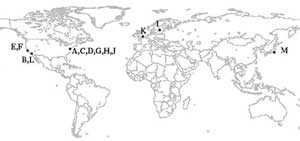Here you can find a summary of innovations in the fields of information and data processing and up-to-date developments on IT equipment and hardware.
This area covers topics such as IT services, IT architectures, IT management and telecommunications.

Can sentient machines evolve?
It’s coming, but when? From Garry Kasparov to Michael Crichton, both fact and fiction are converging on a showdown between man and machine. But what does a leading artificial intelligence expert–the world’s first computer science PhD–think about the future of machine intelligence? Will computers ever gain consciousness and take over the world?
“Computer sentience is possible,” said John Holland, professor of electrical engineering an

A team of network security experts in California has determined that the computer worm that attacked and hobbled the global Internet eleven days ago was the fastest computer worm ever recorded. In a technical paper released today, the experts report that the speed and nature of the Sapphire worm (also called Slammer) represent significant and worrisome milestones in the evolution of computer worms.
Computer scientists at the University of California, San Diego and its San Diego Supercompute

A simpler and more reliable manufacturing method has allowed two materials researchers to produce nanoscale magnetic sensors that could increase the storage capacity of hard disk drives by a factor of a thousand. Building on results reported last summer, the new sensors are up to 100 times more sensitive than any current alternative technology.
Susan Hua and Harsh Deep Chopra, both professors at the State University of New York at Buffalo, report in the February issue of Physical Rev

“The computing world is moving from the desktop and workstation to an arena of embedded and wearable computers,” remarked Sandeep Shukla, who recently received a $400,000 grant from the National Science Foundation to help solve one of the major problems in this transition.
Shukla, who joined the Virginia Tech electrical and computer engineering faculty in August 2002, will use his Faculty Early Career Development Program (CAREER) Award to devise a strategy for achieving the optimal balance

Recording and classifying the behaviour of laboratory rodents is a vital part of a wide range of studies ranging from the discovery of new drugs and detection of harmful side-effects to the biological control of agricultural pests. Until now, it has been a lengthy and painstaking task, requiring human observers to judge, count and record. But a new computerised system developed with EUREKA’s help has done away with the need for human observers, revolutionising the way labs work around the world.

Scientists at the San Diego Supercomputer Center (SDSC) at UCSD analyzing traffic to one of the 13 Domain Name System (DNS) “root” servers at the heart of the Internet found that the server spends the majority of its time dealing with unnecessary queries. DNS root servers provide a critical link between users and the Internet’s routing infrastructure by mapping text host names to numeric Internet Protocol (IP) addresses. Researchers at the Cooperative Association for Internet Data Analysis (CAIDA) at